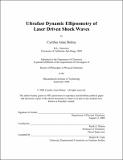Ultrafast dynamic ellipsometry of laser driven shock waves
Author(s)
Bolme, Cynthia Anne
DownloadFull printable version (23.36Mb)
Other Contributors
Massachusetts Institute of Technology. Dept. of Chemistry.
Advisor
Keith A. Nelson.
Terms of use
Metadata
Show full item recordAbstract
The experimental measurement technique of ultrafast dynamic ellipsometry (UDE) was developed for measuring material motion and changes in optical properties of samples under laser driven shock loading. Ultrafast dynamic ellipsometry, a technique based on space-shifted spectral interferometry, uses the time-dependent frequency of a chirped laser pulse to provide time encoding, allowing the picosecond probing of material dynamics in a single shot. With this technique, the sample is probed at two different incident angles with both s- and p-polarized light, which measures the motion of the material and any change in its complex refractive index. Ultrafast dynamic ellipsometry was first used to ascertain the Hugoniot and the shocked refractive indices of thin polymer films of polycarbonate, poly(methyl methacrylate) (PMMA), poly(chlorotrifluoroethylene-co-vinylidene fluoride) (Kel-F 800), and polydimethylsiloxane (Sylgard 184). Next, UDE was used to measure the Hugoniots of liquid samples over a range of nearly one-dimensional stresses in a single laser shot by capitalizing on the spatial energy distribution of the shock generating laser beam. Using the spatially resolved UDE data, the Hugoniots and shocked refractive indices of cyclohexane, toluene, methanol, and water were measured, each in a single laser shot. Two additional liquids, nitromethane and carbon disulfide, were also investigated with UDE, and both liquids showed evidence of chemical reaction in the first 200 ps after the arrival of the shock wave. Ultrafast dynamic ellipsometry was used in conjunction with high-speed schlieren imaging to determine the nature of the insult provided by ablation of a thin titanium film in optical detonators. (cont.) We found that the titanium ablates in fragmented sections, which impact the explosive material to initiate the optical detonators. Finally, UDE was applied to the study of metallic phase transitions. The change in the complex refractive index of crystalline silicon was measured during ultrafast laser induced melting. The fabrication of thin metal films of iron and cerium is described, and preliminary UDE data were recorded in an attempt to probe the ??-?? phase transformation in iron and the ??-?? transformation in cerium.
Description
Thesis (Ph. D.)--Massachusetts Institute of Technology, Dept. of Chemistry, 2008. This electronic version was submitted by the student author. The certified thesis is available in the Institute Archives and Special Collections. Vita. Includes bibliographical references.
Date issued
2008Department
Massachusetts Institute of Technology. Department of ChemistryPublisher
Massachusetts Institute of Technology
Keywords
Chemistry.